In Part 1 of our Intro to Incrementality series, we covered the fundamentals-measuring incremental lift by comparing test (exposed) and control (holdout) groups. In Part 2, we explored how to create accurate control groups using ghost bidding to eliminate bias and avoid skewing incrementality analysis.
Now, in this final installment, we’ll show you how to apply incrementality analysis in real time to optimize your campaigns, improve ROI, and make smarter marketing decisions. From uncovering granular insights to factoring in cost, incrementality isn’t just about measurement—it’s about actionable optimization.
Let’s revisit our basketball analogy a final time: An NBA team hires a shooting coach for one of two players, both of whom start with a 40% free throw success rate. After a year, Player B—who worked with the coach—improved to 80%, while Player A improved naturally to 50%.
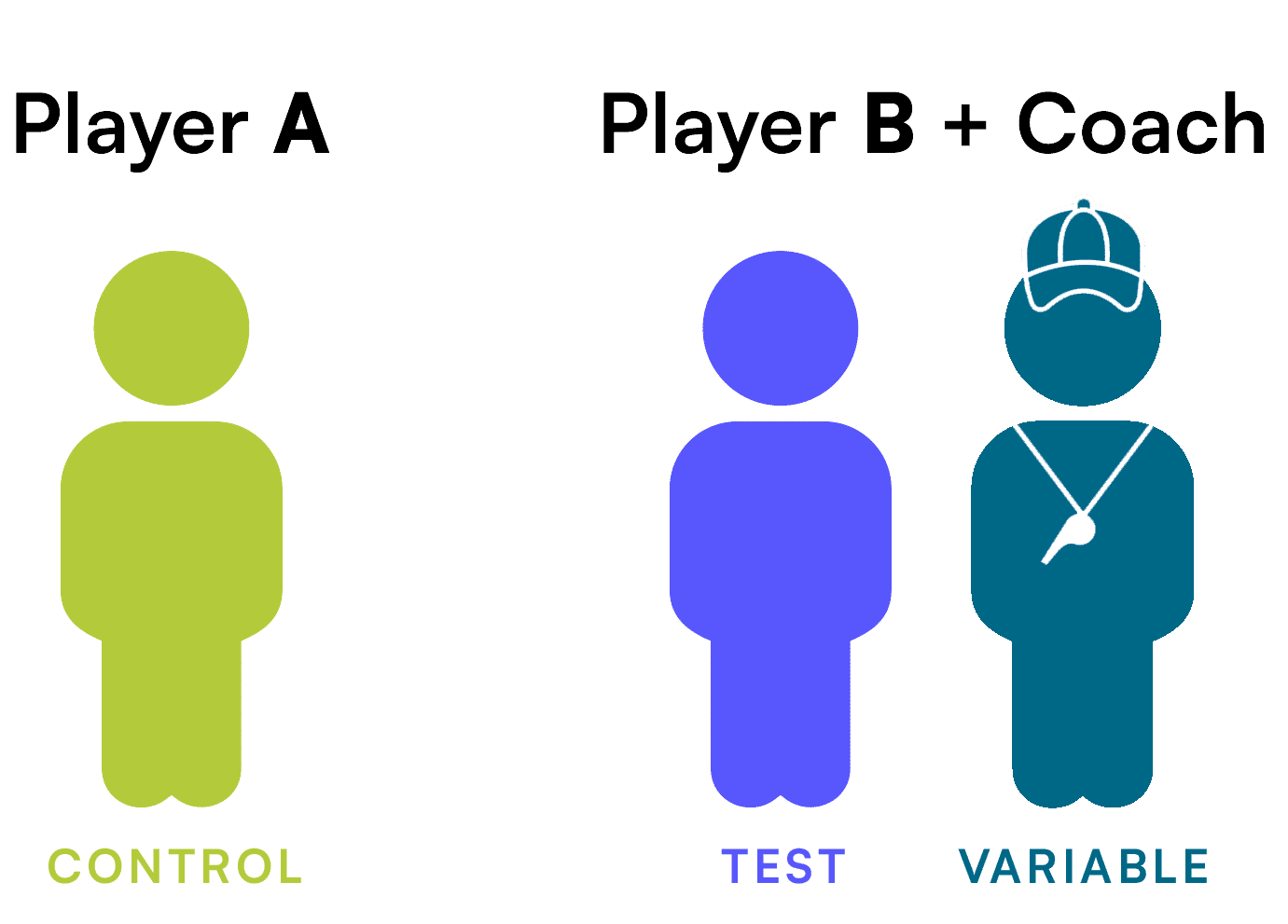
This analogy illustrates the basics of incrementality: the test group (Player B), the control (Player A), and the new variable (the coach). However, it neglects some real-world complexities:
Marketing is no different. Incrementality analysis is messy, nuanced, and ongoing. Let’s clean up the mess.
To make incrementality actionable, brands and agencies must embrace three key principles:
1. Real-Time Analysis
Incrementality isn’t a one-and-done exercise. Marketers don’t have unlimited budgets or the luxury of testing campaigns in isolation. Real-time analysis allows brands to adjust strategies dynamically, optimizing performance as results unfold.
For instance, incrementality after two weeks may differ from results after two months-but early insights can still drive valuable decision-making.
2. Granular Insights
Broad media type analysis (e.g., evaluating all CTV campaigns together) can only tell you so much. Granular insights-breaking down performance by publisher, audience, or creative-are essential for actionable optimization.
For instance, instead of asking whether CTV works, ask which publishers (e.g., Hulu vs. Pluto TV), audiences (e.g., intent-based vs. demographic-based), or creatives (e.g., :15 vs. :30-second spots) deliver the most incremental value.
3. Money Matters
Incrementality analysis is incomplete without factoring in cost. Metrics like cost per incremental action (iCPA) and incremental return on ad spend (iROAS) go beyond traditional cost per action (CPA) and last-touch attribution to ensure your budget is allocated toward the most effective tactics.
A brand adds a $1k CTV test campaign to its marketing mix, which previously included only search and social media. The goal is to optimize to the lowest cost per action (CPA). The campaign tests one creative, one intent-based audience, and three publishers: Hulu, Sling, and Pluto TV.
Here’s the performance data from the CTV campaign based on checkouts and CPA:

At first glance, Sling appears to be the top performer due to its low CPA. But incrementality analysis provides a different perspective:
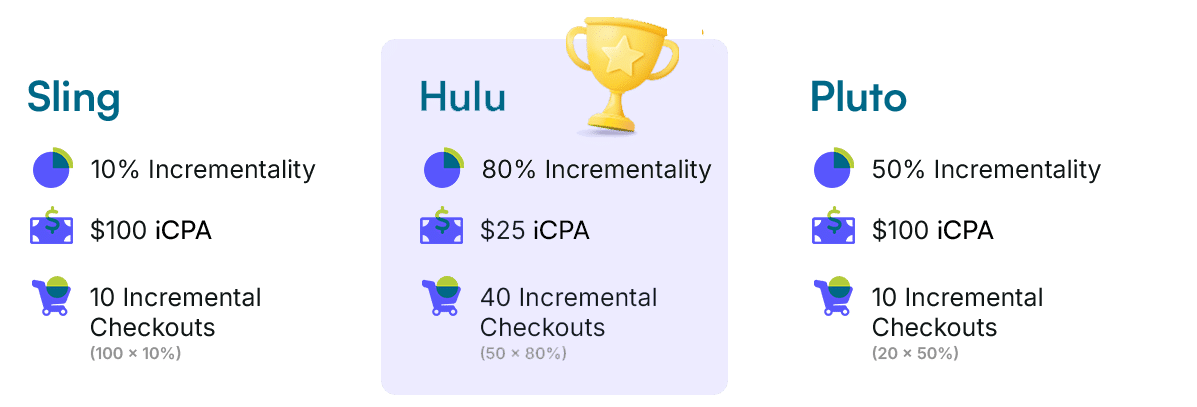
The takeaway? Without incrementality analysis, the brand would have funneled more budget into Sling, optimizing its campaign in a way that was actually counter to its bottom line, toward conversions that would have happened anyway. By incorporating incrementality, it sees that Hulu delivers the lowest cost per incremental action (iCPA) and can reallocate budget accordingly.
This example highlights a common marketing pitfall: platforms and publishers often overreport conversions by attributing them to their own channels, regardless of cross-channel interactions. Incrementality analysis cuts through this noise, giving marketers a clearer picture of which ads and channels drive true incremental results.
Using metrics like iCPA and iROAS ensures smarter budget allocation—not just within a single channel but across your entire media mix.
As brands and agencies become more strategic about their marketing budgets and cross-channel complexity continues to grow, incrementality analysis is no longer optional but essential. It doesn’t just track performance—it answers the fundamental question: Did this ad actually cause the action, or was it just along for the ride?
By working with a media execution partner that applies real-time, granular, and cost-aware optimization strategies, brands and agencies can ensure their media spend drives true impact on marketing performance and business results.
The Digital Remedy Platform not only offers incrementality analysis as a standard feature but also enables advanced ad optimization, ensuring every media dollar is strategically allocated to deliver measurable success.
Ready to make every dollar count? Speak with a member of our team today to learn how incrementality can revolutionize your marketing strategy.
The age-old maxim of “think globally, act locally” isn’t just embraced by marketers for local mom-and-pop businesses. Today, massive multi-location brands and franchises are taking a local-first approach to their performance marketing strategies, helping them better resonate with their target audience.
As customer spending and viewing habits change and the demand for more unique and personalized experiences skyrockets, advertisers are responding by steering their budgets toward regional markets.
For regional marketing managers, whose success is inherently tied to the performance of the stores within their territories, embracing a local-first strategy has never been more crucial..
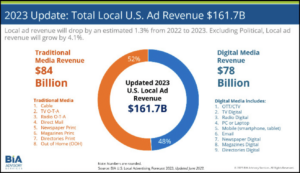
Source: BIA Advisory Services
Based on BIA Advisory Services’ 2023 Total Local U.S. Ad Revenue report findings, key sub-sectors, like automotive, are poised for local growth as we close out the year.
BIA also revises upward its projections for Tier 3—new car dealers and automotive repair services. Other sectors seeing an optimistic adjustment in advertising expectations include financial institutions, loan services, plumbing and HVAC services, and real estate agencies. While political advertising is projected to be a major category in 2024, BIA projects initial spending to kick off in late 2023.
According to eMarketer, local television stations will likely gain from a rebound in automotive advertising as vehicle stock levels rise.
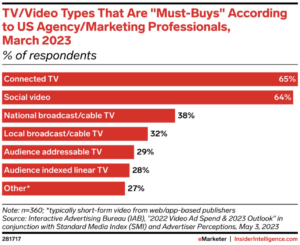
Source: eMarketer
Pre-pandemic, local TV derived approximately 20% to 25% of its advertising revenue from the automotive industry.
There is room for improvement. In February 2023, the automotive industry saw a steep 66.8% drop in the U.S. TV advertising expenditure, attributed mainly to fewer car companies buying high-priced ads for the Big Game than in the previous year, 2022.
There’s no one-size-fits-all approach to regional advertising, but the perks apply to just about any industry and brand—startup shop or national corporation.
When you harness the power of local advertising, you benefit your bottom line through:
Political advertisers especially benefit from local advertising. By investing in local campaigns, they’re able to deliver messaging by region and specific voter districts to achieve targeted impact, drive issue-specific campaigns, and mobilize grassroots support more effectively.
Similarly, national advertisers often opting to buy the most populous markets can reach untapped ones and close any gaps through 100% designated market area (DMA) coverage.
Connected TV (CTV) brings together two key digital agency solutions—the reach of traditional TV and the pinpoint accuracy of streaming—making it an ideal tool for local advertising.
The pillars of its effectiveness lie in its targeting capabilities, creative approaches, and chosen inventory.
The most successful local CTV campaigns use a 360-degree targeting strategy to reach the audiences that perform. These campaign components encompass a mix of tactics, including:
Geo-fencing is ideal for:
Among many other industries, quick-service restaurants (QSRs) reap the many rewards of localized targeting. No matter what they’re whipping up in the kitchen, these eateries can communicate new menu items and promotions available within the region.
If you’re already prioritizing local marketing in your CTV strategy, how well is your creative performing?
The success of your campaign will only be as good as your creative ingenuity.
One particularly effective method is the use of interactive ad formats. Not your run-of-the-mill commercials, these ads invite your audience to engage directly with the content, transforming passive viewers into active participants.
For example, QR codes can be integrated into your CTV ads to bridge the gap between the TV screen and the viewer’s mobile device. A simple scan of the code could take the viewer to a landing page, promotional site, or even a digital shopping cart—encouraging immediate action.
Similarly, dynamic creative allows you to automatically tailor the content based on real-time data. This could mean adjusting the ad’s messaging or visuals depending on factors like the viewer’s location, time of day, or even the current weather conditions.
These creative methods are personalization at its finest, serving up a hyper-relevant experience for each individual viewer.
In the CTV advertising ecosystem, inventory isn’t just a list of available slots—it’s your stage, your platform, and your battleground.
Choosing premium OTT publishers places your brand in elite company, aligning your message with high-quality content that your audience already trusts and enjoys, like live sporting events.
With inventory software, you can leverage premium video ad supply and share your message both:
Plus, take advantage of real-time customization capabilities to adapt and fine-tune your messaging for maximum impact.
With Digital Remedy, you can optimize your regional CTV advertising strategies and gain a better understanding of your local audiences across the board.
Our digital media solutions support the unique goals of all our local partners—retailers, venues, dealers, franchisees, agents, and more—whether it’s to boost brand awareness or drive store/dealership traffic. To give you a holistic overview of your performance, we can also execute a foot traffic study to examine how your digital media channels are contributing to your on-site visits.
From national to proximity-based targeting, we have the power to get as granular as your brand needs. With our innovative media solutions, premium inventory access, and a regional sales team as your performance media partner, we’ll help you leverage these granular insights into your customers with greater levels of measurability to help you better understand what is and isn’t working. We have vast experience optimizing towards the full scope of your KPIs and have successfully executed everything from branding and engagement, down to site visits and ROAS.
Ready to get the most out of your regional marketing efforts? Let’s talk.
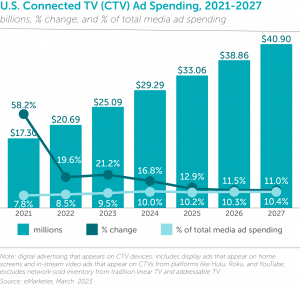
Ad spending on CTV platforms continues with a projected increase of advancements and opportunities in the over-the-top (OTT) and connected TV (CTV) advertising space. As consumer viewing habits continue viewing streaming services ad dollars continue to migrate toward these channels as well.
The industry built tools to better target streaming audiences and measure their viewing behaviors, with the goal of providing the most compelling ad opportunities for marketers looking to connect with valuable consumers. Making up 10% of all digital ad spending, CTV ad spending is expected to reach $29.29b in 2024.1
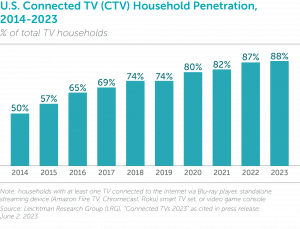
Connected TV penetration in U.S. households continues to grow, as more households acquire internet-connected devices to watch content.2
CTV’s ability to merge the often separated performance and brand marketing worlds is redefining the digital advertising space as we once knew it. Given the immense ad opportunities that CTV/OTT offers—including precise, digital-like measurability and a high-quality viewing environment and the valuable audiences it draws in—and the significant investment in these channels, advertisers and brands are increasingly focused on proving the effectiveness of their OTT campaigns.
Through next-generation CTV ad platforms, marketers can now understand the CTV exposure-to-outcome impact of their ads. Given the large investment in this media channel, attribution—the process of assigning credit for conversions to various marketing touchpoints along the customers’ journey—has become a must-have for growth and performance marketers. This information is critical to creating more effective ad campaigns and boosting revenue. In measuring conversions following ad exposure for CTV, it’s important to understand which exposure caused the conversion to take place. For example, if a person sees an ad for Jersey Mike’s Subs on CTV and grabs their phone to do a quick search for the nearest location, then clicks on the link and places an order. This behavior will be attributed to Google, while in fact the search and the sale were 100% inspired by the TV ad. This faulty attribution dynamic has played out for years, resulting in hundreds of billions of dollars in valuation being hijacked by last-click digital companies.
While some attribution models use basic analytics data, they only provide a template and often fail to account for important steps in the marketing funnel. While last-touch attribution has long been the “go-to” measurement method, marketers now need to explore different attribution methodologies, given the increasingly fragmented media space and evolving consumer journey. The digital ad space needs to advance our understanding of single-touch measurement models, as they assign 100% of conversion credit to only one marketing touchpoint and often focus on only the first or last interactions, and adapt more sophisticated methods of analysis for campaigns. By leveraging different attribution methodologies, marketers can gain more in-depth insights regarding ad effectiveness to drive future marketing decisions.
It’s important to understand that attribution is a journey and the consumer journey is ever-changing. Today, a person can be exposed to a brand’s ad across numerous platforms and devices before purchasing. In fact, in the modern age of marketing across platforms, devices, and channels, the typical retail consumer requires an average of 56 touchpoints before making a purchase.3 It is important to assign proper credit to each touchpoint so that marketers can determine where their budget should be spent.
Our award-winning proprietary Performance CTV platform matches and tracks OTT/CTV impressions across premium inventory sources to real-world events, including site visits, store location visits, subscriptions, app installs, form-fills, purchases, revenue, and more to provide a more granular look at the consumer journey. We know, deterministically, at the household level, when someone is exposed to an ad and then takes action—whether it be digitally or physically. With our platform, advertisers can analyze exactly what’s driving desired results among consumers using multiple attribution methodologies.
Our Performance CTV platform takes attribution a step further, measuring every single touch prior to a conversion. Powered by innovative technology, the platform allows users to toggle freely between four different attribution methodologies in real-time to see exactly which touchpoints are driving the most leads, sales, installs, or visits among consumers. Advertisers have the ability to shuffle the distribution of credit according to the following attribution methodologies:

First Touch: All conversion credit assigned to the first variables that the converter was exposed to.

Last Touch: All conversion credit assigned to the last variables that the converter was exposed to.

Time Decay: Credit weighted more heavily across variables that the converter was exposed to as said exposures approach conversion (aka credit increases as time to conversion decreases).

Linear: Credit evenly dispersed across all variables that the converter was exposed to.
Our Performance CTV platform is the one-stop-shop for advertisers and agencies looking to transform data into actionable items that can be leveraged and improved upon in the future. By measuring and assigning credit to different variables in your campaign, our platform determines the true impact of each of them on any KPI—providing a new standard in tracking, transparency, and results via comprehensive attribution insights. Our platform then uses these insights to inform its media buying with a bidder that moves the budget toward the highest-performing campaign variables—lowering CPAs, maximizing ROAS, and making a tangible impact on a brand’s bottom line. Expanding your attribution methodologies will not only help refine your budget strategy but will have a lasting impact on your current and future ad campaigns.

Sources:
With the influx of new marketing channels finding their place in the modern digital age, advertisers worldwide are launching campaign after campaign across a broad spectrum of mediums, from Google paid search to linear and CTV.
There’s no doubt that this omnichannel approach does wonders for driving greater brand exposure and customer engagement. Of course, the more screen time you get, the more likely your most valued audience will see your message and decide to act, regardless of what that next step looks like for your specific brand.
But the rise of multi-channel strategies, and even those singular ones, also poses a pressing challenge to the everyday digital marketer: accurately tracking sales and conversions.
Fortunately, the right attribution model will deliver the insights you need to know exactly what is driving your consumers across channels — all the way from initial ad exposure to conversion.
Every digital advertiser benefits from not only determining how a customer came across their ad but also how they progress through the marketing funnel.
Because the average online customer journey now ranges from 20-500 touchpoints, it’s important to recognize that a lot of interaction happens before your customer decides to make a purchase.
With marketing attribution, you can go in-depth to fully understand the impact of different touchpoints along the customer’s journey — from beginning to end — and discover which channels contribute to a conversion.
These findings provide you with measurements of the successes and/or challenges of your campaign’s online presence and help you track your investment to determine your return on investment (ROI). When you leverage attribution models, you’ll have assistance outlining the resources you plan to use in future campaigns more effectively, helping you work towards the goal of actually increasing your ROI over time.
The process of attribution is not an easy undertaking for all, but it is crucial to understand. Without the right methodology, you’ll quickly find yourself in the dark with your campaigns, unaware of what’s truly impacting your brand’s bottom line.
From last touch to time decay, different attribution methodologies offer their own distinct advantages.
That’s why using multiple attribution models is highly recommended for an accurate understanding of the customer’s journey in full.
But to reap the best benefits for your brand, you’ll need to select the right attribution models for your campaign, and that decision starts with acknowledging the specific use cases of each.
The most common attribution model, last touch, determines an estimate of a customer’s last touchpoint with your brand before making a purchase or signing up for a service. Often referred to as “last click” or “last interaction,” this model gives all the conversion credit to the final touchpoint and offers a highly granular glance at your marketing cycle’s conversion points.
Advantage:
Disadvantage:
Just like last touch, the first touch model is another attribution methodology that assigns 100% of the conversion credit to a singular interaction a consumer has with your brand. This time, however, emphasis is placed on the first touchpoint a customer has with your company, with the main idea being that the initial interaction was the primary selling factor.
Advantage:
Disadvantage:
Unlike last and first touch, the linear model is a multi-touch attribution methodology, taking into account several touchpoints along the customer journey. What’s more, this methodology doesn’t just consider all the ways in which a customer interacted with your brand — it also splits conversion credit equally across each touchpoint, offering a balanced look at your marketing strategy in its entirety.
Advantage:
Disadvantage:
Similar in nature to the linear model, the time decay methodology assigns credit to all of the marketing channels that led to a conversion. However, unlike the evenly distributed credit provided by the linear model, time decay places more weight on the later touchpoints, with credit lessening — or decaying — as you look further back into the customer’s journey.
Advantage:
Disadvantage:
Attribution is the math and science of digital marketing, and it’s not always easy to navigate right off the bat.
To effectively leverage attribution data and boost your chances of conversion success, it’s best to:
As the digital landscape continues to advance, marketers need to stay ahead, and those that master campaign measurement with multiple attribution methodologies will be best positioned for success.
To fuel your future media budgets and marketing decisions, it’s critical to identify what channels are driving conversions and understand how your channels work together to influence those conversions.
With Digital Remedy as your media partner, we’ll help you determine the best attribution model(s) for your campaigns with specialized optimization, incrementality, and halo effect methodologies.
Speak with a member of our team to learn more, and check out our full video on YouTube.
Blog posts:
Despite what the 21st-century surge of cord-cutters and cord-nevers may lead you to believe, linear TV and the long-stay impact of its advertising capabilities won’t be headed for demise anytime soon.
There’s no doubt that the era of streaming and OTT/CTV is well upon us—reaching 142 million adult viewers across the globe—but abandoning the traditional TV marketing method might just lead to more campaign losses than gains.
Like most things in marketing, the best TV advertising efforts exist in a unit, and a diversified strategy—using both CTV/OTT and linear in tandem—keeps your brand relevant, in touch with your most valued leads, and seeing greater results.
A decades-old household staple, linear TV boasts a history of success at driving scale and delivering a broad reach for advertisers.
In recent years, however, the industry has experienced a significant disconnect, leaving many marketers looking to tack on other mediums to their strategy, particularly digital and CTV/OTT.
The age of converged media strategies has been a long time coming, and it’s not just because there are more opportunities than ever to get your brand known. Challenges in today’s linear TV landscape are taking marketing teams back to the drawing board, especially when faced with roadblocks like:
The evidence supporting convergence media approaches is here, and the figures are more than telling. According to a MediaScience/Effectv study, viewers exposed to TV and digital ads—versus digital ads alone—spent 3x more time with the ads, had a twice better brand recall, and rose their purchase intent by 15%.
But the power of combining CTV and linear is still unfolding, and advertisers going into this year’s first multi-currency upfront still cite fragmentation and measurement as top challenges in the converged TV space. Despite the industry’s current pain points, forward-thinking marketers are still embracing the potential of what a convergent media strategy can do, what its future holds, and how it can fit into their budget.
Ad dollars are moving, and what’s behind the migration is the eager marketer ready to capitalize on the impact of convergent media.
While search and social, mobile apps, and digital display continue their reign as the preferred channels for direct-to-consumer (DTC) marketers—receiving the largest shares of ad dollars in 1H 2023—a growing number of brands are shifting budgets to support increased spending on CTV/OTT.
In fact, 65% of those investing in CTV/OTT advertising in 1H ’23 report it being their first time funneling dollars into the channel, and over half (57%) of all marketers opting for this digital solution will spend more on it than this time last year.
By allocating extra budget to performance TV, advertisers have a leg up in not only staying competitive and reaching a highly targeted audience but also remaining insightful of their campaigns’ true impressions.
Because of the combined, rich data of performance TV and linear TV, over two-thirds of DTC marketers are leveraging CTV/OTT campaign insights to influence and optimize their linear strategies—and hail bigger results.
TV insights deliver the data you need to refine your marketing efforts and make more informed decisions on the who, what, how, when, and where of a successful campaign. Using these linear and CTV/OTT performance insights, you can enhance your advertising strategy and better resonate with your audience in three different ways:
Whether your main goal is fueling your branding, performance, or both, determining the best ways to go about your strategy is made possible with comprehensive TV insights, particularly when it comes to ACR technology.
The everyday smart TV is one of the primary propellors of granular TV insights. With automatic content recognition (ACR) technology built into these devices, smart TVs are able to identify nearly any content—including linear and CTV—playing on-screen and serve as grounds for immense data collection, helping advertisers with:
Although the total number of ACR-enabled TVs currently on the market is unknown, Vizio accounts for over 21m devices as of April 2023, signaling that marketers have plenty of ACR data sources to tap into for their CTV and linear campaigns.
CTV/OTT without data-driven linear TV advertising (and vice versa) is like developing a media buying plan without an experienced media planning strategist in your corner.
It meets the mark, but at what cost to your campaign?
These complimentary marketing tactics are best when leveraged together, and it’s not just because they reach a much wider audience. When you prioritize the combined power of a convergent TV strategy, you can:
It’s easy to fall into the trap that the cord-cutting phenomenon is positing—linear TV is on the decline. However, current viewing numbers suggest that we’re not quite there yet, and ditching traditional TV is only jumping the gun since it accounts for just under 50% of daily views. It still remains a highly saturated medium, and by keeping it in the modern era marketing landscape, advertisers are able to maximize their spending in more ways than one.
When you embrace the capabilities of both performance and linear TV, you’ll boost the data at your fingertips, the reach of your campaigns, and the relevance of your brand, all while staying in touch with industry standards.
CTV viewership and adoption continue to grow, and with it comes a proliferation of Performance TV, from ad-supported and subscription models to a hybrid of both.
Using TV insights through Digital Remedy, you can optimize your buys across digital by taking into account real-time linear TV data, increasing transparency in your TV buys, finding those hard-to-reach audiences, and measuring more effectively. With our customized digital media buying solutions, we’ll help you tap into your most telling insights and drive your future campaign strategies in ways that deliver the highest return on your investment.
Even more, advertisers can now run their linear media with us, bringing TV planning, activation, and measurement all under one roof. Listen to our RVP, West Coast, Mike McLaughlin expand on why and how Digital Remedy helps advertisers converge their linear and CTV strategy.
Ready to take your TV campaigns to the next level? Speak with a member of our team to learn more.
As the direct-to-consumer (DTC) space becomes increasingly competitive, marketers are under constant pressure to understand campaign performance and prove the value of their efforts. Now accountable for driving outcomes through their campaigns rather than building general awareness among consumers, many brands are rethinking their media mix—exploring new channels that can effectively deliver on their campaign goals and maximize their budget.
Digital Remedy partnered with Dynata, the world’s largest first-party data company, to field a marketing-focused survey with the goal of gaining a deeper understanding of DTC marketers’ top priorities, current campaign practices, and media partner preferences.
Download our report, which provides valuable insights, including:
For the latest industry trends and insights, check out our blog and sign up to receive our monthly newsletter.
Whether you’re a DTC marketer just getting started in the CTV/OTT space or looking to take your current campaigns to the next level, Digital Remedy is here to help. Discover how your brand can garner greater brand impact, generate more outcomes, and turn TV into a powerful performance channel. For additional information, visit www.digitalremedy.com/ott-ctv or schedule a demo to see our award-winning platform in action.
Behind every paid digital ad is what seasoned marketers know as a media buy.
Gone are the days of simply throwing money at digital ads and hoping it sticks. Digital ad buying, also known as media buying, is a process that requires strategy, thought, and creativity — making it much more than just putting a flashy message in front of audiences at scale.
With the right media buying tips and tricks, you can create a fruitful strategy that drives real returns on your investment, no matter what your campaign goals look like.
Your ad may be visually appealing and get the message across, but without the right media buy, it won’t get you very far.
Media buying is a science. Strategy is crucial—and it starts before you even start buying. Media buying is all about finding the proper environment, time, and context to run your ads. The goal is simple: to get ad space on the most relevant channels to your target audience at the most optimal time — all for the least amount of spend.
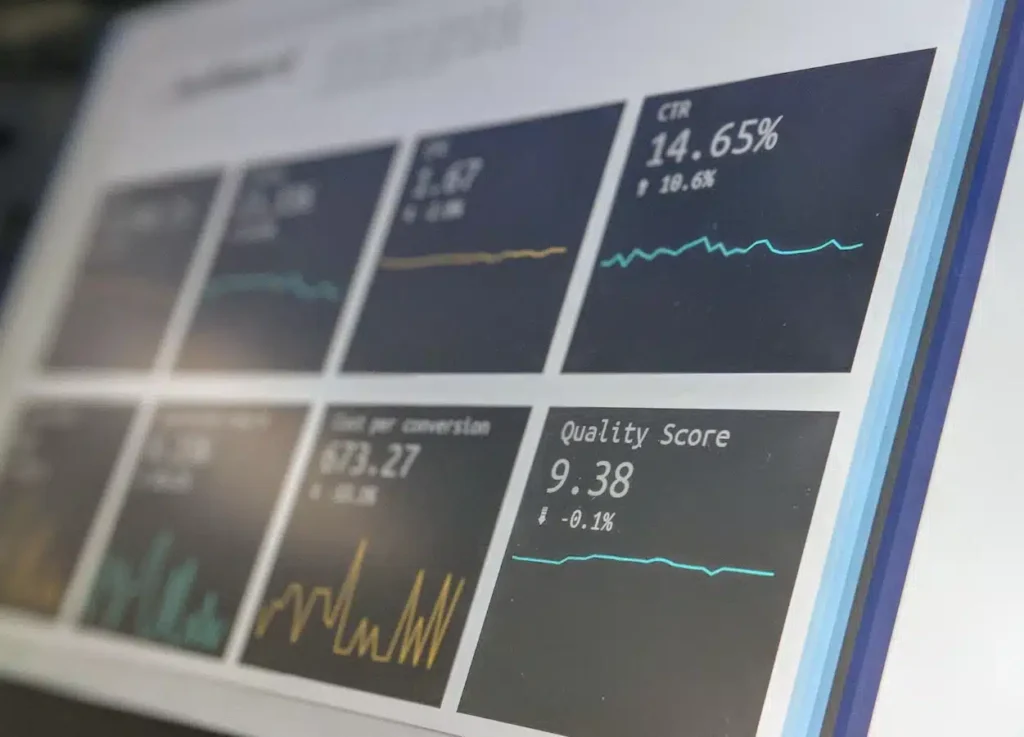
Today, there are several ways to purchase media for your ad campaign, including:
No matter how you do media buying, one thing is standard: It’s a multi-step process that goes beyond the simple act of buying ad space. Media buying, especially in the performance TV and CTV age, requires careful consideration and planning to effectively bring your innovative ideas to fruition and keep up with the rife competition.
In short, it’s no longer enough to just have compelling copies and visuals. Because media buying can affect your company’s bottom line, your ads need to be placed in the right locations and at the right times and frequencies so that the right audiences see your message.
An effective media buying plan helps you get the most out of your advertising, but to see the results you’re after, you need to go about it the right way.
Here are a few tips for maximizing your media buying strategy:
According to Marketing Evolution, $37b is wasted in ad spend each year from ads that fall short of engaging the target audience.
The takeaway?
Understanding your target market in any campaign you take on can make or break your media buys. This starts with knowing their age, gender, income, location, interests, and more — and putting all that data to good use.
Ensure that your ad buys are delivering a solid ROI and expand your market size by choosing who you want to deliver your ads to. By discovering potential prospects, you’ll be able to uncover practical ways of targeting select user pools to generate the most qualified leads.
Big or small, startup or seasoned — whatever your brand looks like, it can’t be without a campaign objective.
What are you hoping to achieve with your media buy? Are you a newer company trying to raise brand awareness? An established brand looking to remarket one of your products? Was there a dip in ROI last year that you’re trying to mend this time around?
When looking toward the media buying process, you need clearly established goals before planning the creative. Consider your intentions and how you want to measure success, including any relevant KPIs.
Media plans only work if you strategize toward distinct and well-defined goals.
Today, 88% of U.S. households tune into at least one video streaming service, whether it’s to binge Prime Video or catch the next big game without paying for cable.
This is where doing the most to reach your audience becomes crucial.
To stand out in an increasingly saturated market, you need to ensure your ads appear on brand-safe inventory sources at relevant, accessible, and visible times.
How? By choosing media channels that will have the most significant impact on your target audience.
With an integrated media planning approach, you can focus on buying the right mix of media to maximize your investment, whether that looks like OTT/CTV and paid search, social, or whatever else may fit the bill.
Media buying isn’t just a one-and-done success story. It’s an ongoing optimization process that involves four key tactics — learning, analyzing, testing, adjusting, and repeating — to make a real difference in your campaign’s performance.
Whether it’s adjusting frequency and bids to maximize performance or shifting spend toward top-performing devices, you should be optimizing your ads in real-time to ensure your programmatic campaign is set up with appropriate parameters throughout the flight.
By doing so, you’ll have greater control over the outcome of your ad buys and verify they’re doing what you intended them to do.
Buying media ads may seem like an easy feat, but DIYing your purchases often ends up with a campaign that only half works. To maximize your efforts, it’s best to partner with a knowledgeable media buying partner.
Experienced media buying strategists help you get the best ad placements, deals on your buys, and more with a reservoir of technology, expertise, and best practices to inform your campaign.
When you work with a skilled and trustworthy buying partner, you can benefit from solid, already-established relationships with outlets and publishers to successfully place, buy, and reconcile your ad spend.
That way, you can achieve the best possible results by driving quality impressions at a lower cost — without the extra heavy lifting.
At Digital Remedy, we execute our clients’ media as if it’s our own.
Leveraging over 23 years of industry experience, we strive to overachieve outcomes that maximize performance and efficiency for our clients by utilizing reporting data and testing various solutions.
With our digital media solutions, we seek success from uncommon data and solutions points that yield strong performance.
When you partner with Digital Remedy on your digital media planning and buying initiatives, you’ll gain:
To learn more about how we can help you meet your digital ad buying goals, reach out to a member of our team to schedule a demo today.
Through sophisticated measurement capabilities, marketers can now understand the impact of CTV exposure-to-outcome on their ads. Given the significant investment in this media channel, attribution—the process of assigning credit for conversions to various marketing touchpoints along the customers’ journey—has become a must-have for growth and performance marketers. This information is critical to creating more effective ad campaigns and boosting revenue. In measuring conversions following ad exposure for CTV, it’s important to understand which exposure caused the conversion to take place.
Through incrementality analysis, we can evaluate all the conversions that wouldn’t have happened without our media. However, in many instances, other media channels had an influence. In fact, every touchpoint your audience has with your campaign influences a conversion—no matter the partner or channel.

If a Digital Remedy campaign played a part in a conversion that involved other media exposures, clients want to understand how the exposure to Digital Remedy played a role in improving the efficacy of the media. In this case, the OTT campaign influenced the conversion, but the second partner’s attribution modeling wouldn’t take that into account, and it would get full credit for the conversion.

All media works together. None of your advertising works in a vacuum. Conversion reporting/attribution is only one of several ways to analyze whether specific media works for you. With halo effect analysis, clients can understand the campaign boost Digital Remedy is providing. If we played a part in a conversion that involved some other media, we’re essentially improving the efficacy of that media type with our own media.
Incremental channel lift, or halo effect, is a way to measure the boost in performance of your search, social, and affiliate channels provided by your CTV campaigns. In other words, the halo effect shows how much more likely someone is to convert if they see CTV ads AND any of your search, social, or affiliate ads versus ONLY seeing ads on those other channels.
Halo effect analysis takes a more holistic approach to attribution, focusing on incremental conversions across media channels and campaigns. With this analysis, you can connect your CTV spend and see just how much of a boost these campaigns are providing for all of the other media you’re running.
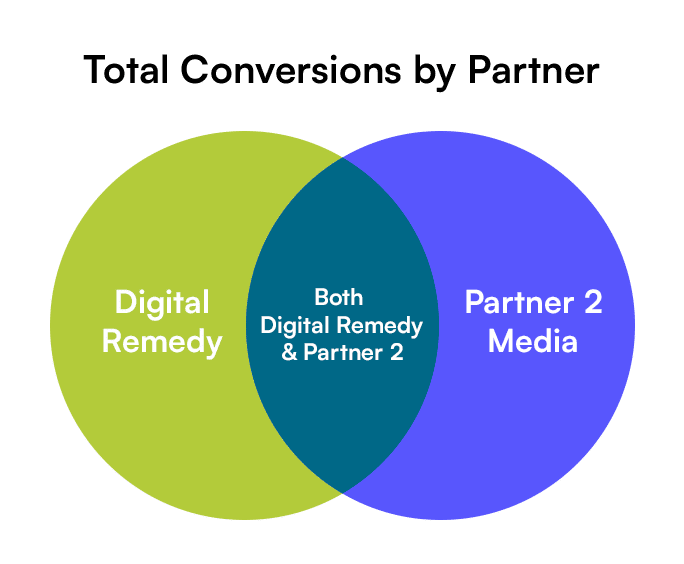
Rather than having to take credit for the direct performance of our media, we are able to assign that credit and take indirect credit instead through halo effect analysis. Search lift, social lift, affiliate lift, native lift; you name it, all of this can be done through this same process.
Leveraging halo effect analysis through Digital Remedy, advertisers can measure the true incrementality of their marketing initiatives and refine their campaign mix to deliver a better ad experience for their customers (and better results for their business). Benefits include:
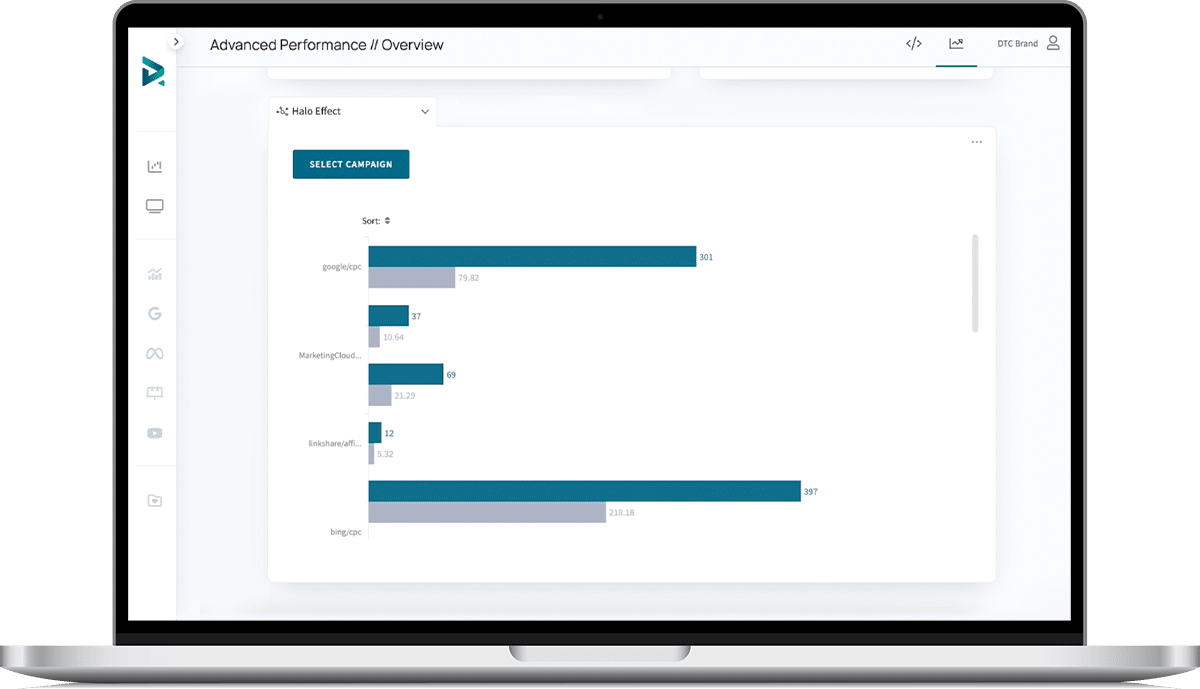
Speak to a member of our team to learn more.
With the lines between branding and performance marketing blurring, the days of archaic, one-size-fits-all ad campaigns are over.
Creating an OTT/CTV performance campaign that works and works well relies on a number of things, but what trumps the list in 2023 may be more holistic than what we’ve seen in past years.
To ensure your connected TV advertising efforts are optimized for success, you need to know what makes an effective performance marketing strategy aligned with today’s best practices.
When starting a connected TV campaign, marketers face a choice: Is this a branding or a performance campaign? Not that the two are wholly mutually exclusive—a branding campaign will have a performance impact and vice versa—but the choice between the two will determine the primary campaign objective.
With a branding campaign, your main goal is to build brand equity—establishing your value proposition regarding your reputation, values, quality of offerings, and trustworthiness, all in the minds of your customers. This type of marketing is mainly used to raise awareness about your overall brand, or it can be an effective way to generate hype on the product level, particularly when it comes to a new launch.
These campaigns involve slow-burning strategies, and their return on investment may not occur immediately—rather, taking weeks, months, or even years to witness real results. Along the way, however, you can track KPIs to measure how well your brand is resonating with your audience with metrics like engagement and interaction.
On the flip side, performance marketing aims to improve brand performance and impact real-world outcomes like sales, leads, or site traffic. Digital marketers who choose this type of media planning strategy have high hopes of guiding their audiences through the marketing funnel all the way to conversion. Performance marketing implies 2 key facets:
With high-volume lead generation and quick, easily trackable ROI, performance marketing is favorable for immediate results or when budgets are tighter, where every out dollar must correspond to an equal or greater amount in. Powered by personalized messaging, clear calls to action, and compelling ad ideas, these campaigns encourage viewers to respond directly to the ads in ways that drive bottom-funnel KPIs.
Traditionally, branding and performance have existed as two completely separate disciplines: Branding as a long-term strategy; performance as a short-term one. Branding to drive perception; performance to drive demand. Branding as a trust builder; performance as a sales pitch.
The list goes on.
Fortunately, the gap between brand and direct response marketing is starting to close, and advertisers are no longer left scrambling to pick a side of the coin.
Measurements for what were once considered upper-funnel media channels are starting to improve, highlighting what many advertisers may have missed all along: Lower-funnel media can impact branding, and upper-funnel media can impact performance.
Brands are now paying equal attention to how they tell their story and the ways they target and measure their true impact.
Bridging the gap no longer entails a drastic shift in mindset—there’s an art and science to both that can never fully merge. But a clear alignment of the two will bring about a holistic, granular understanding of the effects of your cumulative investment, considering the nuances of every stage of the buyer’s journey.
When marketers combine the data, technology, and benefits of the two once-opposite disciplines, they can craft strategies with both long-term brand awareness and measurable outcomes.
Savvy marketers know that bringing an ad idea to life isn’t just about the desired outcome—it’s also about the right creative. With the average person seeing an estimated 6,000-10,000 ads a day, cutting through the clutter is no easy feat unless your ads are made to be remembered.
Whereas linear TV was once the traditional branding channel, recent advancements in ad tech have brought newer, more innovative opportunities to deliver an incredibly engaging audience experience.
OTT/CTV, in particular, offers the high-impact brand storytelling power of traditional TV coupled with the targeting, analytics, and interactivity of digital. These capabilities create a compelling environment for audiences to interact with messaging alongside premium content, helping to drive conversion rates.
When launching a creative strategy that works for your brand and advertising goals, it’s important to segment your marketing channels by funnel level and different messaging strategies based on customer touch points. You’ll need to plan to allocate your spending based on:
The right creative strategies look different for every marketer, and they aren’t built overnight. But with knowledge of the industry’s best practices, you can ensure your strategy is up to code, speed, and the standards of your target audience.
A performance marketing strategy that combines the best of both worlds—branding and direct response—can be a shot in the dark if not executed correctly. To avoid blindly firing into the abyss, you need to cultivate an expert media buying strategy that hits the target without misses.
Some of the industry’s best practices to keep in mind as you navigate a multi-dimensional performance marketing strategy include:
Discover how incrementality analysis helped our QSR client determine which creative messaging drove the highest incremental lift. From these insights, the client shot additional video spots that aligned with the high-performing messaging.
Performance means different things to different marketers (and has traditionally been associated with direct response). At Digital Remedy, we believe in having a solid base for delivering performance, no matter the KPIs (upper- or lower-funnel)—meaning more outcomes and more ROI for our clients.
We’ve spent 22+ years building and evolving the best performance solutions in the market—while providing a new standard in tracking, transparency, and results via comprehensive attribution insights.
Performance is at our core. Our omnichannel performance branding solutions enable advertisers and agencies to effectively activate, measure, and draw insights across the right channel to drive a stronger impact and performance outcomes.
We recognize the importance of understanding the complete consumer journey so that no marketing funnel stage is ever optimized in isolation. Your consumers’ attitudes and behaviors are bound to change—meet them where they are with a flexible, agile approach and platforms that evaluate your most effective journey to purchase.
Speak with a member of our team to learn more about how we can help you maximize your OTT/CTV performance strategy today.
A movement of possibility for CTV/OTT advertisers is coming, and it’s hitting full force in 2023.
Whether you’re just making the jump to CTV or looking to improve your overall campaign performance, a new year on the books marks new ways of winning over your audience.
To the average TV fanatic, the shift from linear programming to digital streaming won’t be making any groundbreaking headlines in 2023. For over a decade, CTV has consistently created waves in the steady stream of modern media, redefining how, when, and where we tune into this week’s top-charting shows and films.
As the number of cord-cutters surges, digital marketers are just now taking the hint. Getting an ad placed during Amazon’s Thursday Night Football carries a lot more weight than a strategy sealed off to the age of OTT.
In 2023 alone, CTV ad spending is expected to reach $26b—up $5b from the past year.
Between Disney+ and Netflix’s move to ad-supported streaming in late 2022, there have never been so many opportunities to get your ads seen and your brand known. But as any digital marketer knows, no advertising strategy wins the deal unless it’s agile to emerging trends in the industry.
Since the dawn of marketing, creativity has been the saving grace for advertisers trying to cut through the clutter of a noisy media landscape. With the average consumer’s attention span resting at just eight seconds, the performance of an ad has everything to do with how well it resonates with its viewers.
While Prime Video, Paramount+, and Netflix pool more and more eager marketers to CTV, an innovative ad-buying strategy is no longer optional for brands who want to see real results with their campaigns. To stand out from the rising competition, marketing moguls are embracing creativity not just within their messaging but also in the types of ads they choose to purchase.
Interactive ads, in particular, have seen considerable success as they’ve been adopted into performance TV strategies. According to data from Innovid, interactive ads boast a 3.5% higher engagement rate and capture audience attention for 85 seconds longer than traditional streaming ads.
There are many different ways to have your audience interact with your brand beyond the dreaded blank stare at the screen. In recent years, some of the most popular trends that have taken hold of the industry include:
Unlike standard TV, CTV ad buying is flipping the script on the traditional passive user experience. Forbes sums up this emerging trend perfectly: The more engaging the advertising, the longer the viewer’s impact—and the higher the chance that your brand remains top-of-mind when it matters most.
As streaming TV advertising becomes more competitive and expensive, marketers need to measure the success of their campaigns to maximize their ROI. Luckily, programmatic ad platforms offer a boatload of data on the status of CTV campaigns, from top-of-the-funnel metrics down to conversions by the number.
Historically, some of the most common metrics tracked in performance TV advertising have been those that sit at the top of the marketing funnel. Whether it’s the cost per completed view or the number of households reached, measuring CTV performance has largely remained geared towards metrics that move the needle on brand awareness.
Looking into 2023, performance advertisers are now leveraging metrics with a more telling focus: consumer behavior after viewing an ad. As the ring bearer in the marriage between TV and the Internet, CTV can track lower-funnel metrics untouched by linear programming, such as:
These lower-funnel performance metrics allow marketers to measure the effectiveness of their campaigns in terms of customer acquisition, engagement, and retention. That way, you can track how much you’re spending to acquire views, what your return on ad spend is, and the lifetime value of your customers.
It’s a digital marketing no-brainer: To meet your target audience where they are, you need to understand them first.
From paid search to OTT, consumer data such as demographics and contact information has long been used to create a more informed and intuitive campaign. But where advertisers have previously relied on second and third-party data to obtain their insights comes a new industry standard—first-party data.
Within any marketing medium, first-party data is data that you collect from your audience without any middleman. It’s the most reliable, credible, and trustworthy data you can gather because it’s overseen entirely by you. And because it’s proprietary to you, your competition won’t get the chance to create personalized campaigns based on your findings.
Some of the most common ways first-party data is collected include:
With privacy policy changes raining down on the advertising industry, it’s never been more important for marketers to gain their information from a consenting audience. Even Google plans to phase out third-party cookies in Chrome by 2024 to better protect its searchers from invasive data collectors looking to make big bucks.
As the ad tech industry moves toward data obtained on the inside, marketers now have increased opportunities to get to know their audience and establish more trustworthy relationships first-hand.
With more OTT platforms rushing to adopt ad-supported tiers, more options are being unveiled for advertisers looking to make their way to the big screen. But despite this influx in opportunity, advertisers worldwide are picking up on the idea that not all inventory is created equal.
CTV/OTT inventory is professionally developed and curated content that couples broadcast TV quality with full-screen creative ads. When it’s considered premium, it’s just that—premium-grade, professional content designed to reach the right audience at scale.
Because streaming TV has risen to the title of one of the world’s largest markets, a fragmented landscape has left room for greater brand safety risks. Brand owners can no longer afford to put their full trust in open exchanges since their ads can run almost anywhere, risking heavy blows to their reputation and financial status.
To combat ad fraud, more marketers are working with CTV advertising partners that leverage premium inventory. When you launch your campaigns through a trustworthy provider, you can ensure that your ads are being run in brand-safe content, protecting your efforts from unwittingly doing more harm than good.
In the ever-evolving digital marketing landscape, it is vital to have a strategic media planning partner on your side to ensure success in your campaigns.
At Digital Remedy, we provide comprehensive digital media solutions to help you navigate the complexities of today’s rapidly-changing CTV environment. We combine our extensive industry knowledge and expertise with cutting-edge programmatic ad platforms to create custom digital strategies and powerful campaigns that drive results.
Whether looking for a turnkey solution or more hands-on guidance, Digital Remedy has the experience and resources to help you achieve your unique goals.
Reach out to us today to learn more about how we help you stand out from your competition.